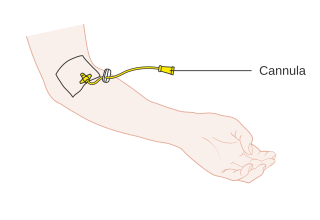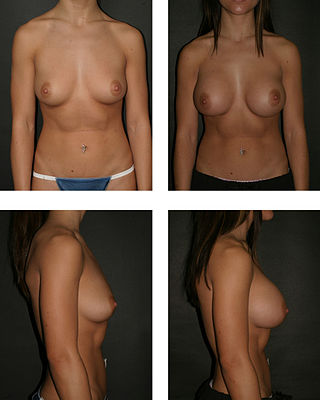
Botulinum toxin, or botulinum neurotoxin, is a highly potent neurotoxic protein produced by the bacterium Clostridium botulinum and related species. It prevents the release of the neurotransmitter acetylcholine from axon endings at the neuromuscular junction, thus causing flaccid paralysis. The toxin causes the disease botulism. The toxin is also used commercially for medical and cosmetic purposes.

Plastic surgery is a surgical specialty involving the restoration, reconstruction or alteration of the human body. It can be divided into two main categories: reconstructive surgery and cosmetic surgery. Reconstructive surgery includes craniofacial surgery, hand surgery, microsurgery, and the treatment of burns. While reconstructive surgery aims to reconstruct a part of the body or improve its functioning, cosmetic surgery aims to improve the appearance of it. A comprehensive definition of plastic surgery has never been established, because it has no distinct anatomical object and thus overlaps with practically all other surgical specialties. An essential feature of plastic surgery is that it involves the treatment of conditions that require or may require tissue relocation skills.

A cannula is a tube that can be inserted into the body, often for the delivery or removal of fluid or for the gathering of samples. In simple terms, a cannula can surround the inner or outer surfaces of a trocar needle thus extending the effective needle length by at least half the length of the original needle. Its size mainly ranges from 14 to 26 gauge. Different-sized cannula have different colours as coded.

Phosphatidylcholines (PC) are a class of phospholipids that incorporate choline as a headgroup. They are a major component of biological membranes and can be easily obtained from a variety of readily available sources, such as egg yolk or soybeans, from which they are mechanically or chemically extracted using hexane. They are also a member of the lecithin group of yellow-brownish fatty substances occurring in animal and plant tissues. Dipalmitoylphosphatidylcholine (lecithin) is a major component of the pulmonary surfactant, and is often used in the lecithin–sphingomyelin ratio to calculate fetal lung maturity. While phosphatidylcholines are found in all plant and animal cells, they are absent in the membranes of most bacteria, including Escherichia coli. Purified phosphatidylcholine is produced commercially.

Breast augmentation and augmentation mammoplasty is a cosmetic surgery technique using breast-implants and fat-graft mammoplasty techniques to increase the size, change the shape, and alter the texture of the breasts. Augmentation mammoplasty is applied to correct congenital defects of the breasts and the chest wall. As an elective cosmetic surgery, primary augmentation changes the aesthetics – of size, shape, and texture – of healthy breasts.

Deoxycholic acid is a bile acid. Deoxycholic acid is one of the secondary bile acids, which are metabolic byproducts of intestinal bacteria. The two primary bile acids secreted by the liver are cholic acid and chenodeoxycholic acid. Bacteria metabolize chenodeoxycholic acid into the secondary bile acid lithocholic acid, and they metabolize cholic acid into deoxycholic acid. There are additional secondary bile acids, such as ursodeoxycholic acid. Deoxycholic acid is soluble in alcohol and acetic acid. When pure, it exists in a white to off-white crystalline powder form.

Sclerotherapy is a procedure used to treat blood vessel malformations and also malformations of the lymphatic system. A medication is injected into the vessels, which makes them shrink. It is used for children and young adults with vascular or lymphatic malformations. In adults, sclerotherapy is often used to treat spider veins, smaller varicose veins, hemorrhoids, and hydroceles.
Lip augmentation is a cosmetic procedure that modifies the shape of the lips using fillers, such as collagen or implants. The procedure may be performed to increase lip size, correct asymmetry, create protrusion, or adjust the ratio of the top and bottom lips. The procedure typically involves surgical injection, though temporary non-surgical alternatives exist.

Gluteoplasty denotes the plastic surgery and the liposuction procedures for the correction of the congenital, traumatic, and acquired defects and deformities of the buttocks and the anatomy of the gluteal region; and for the aesthetic enhancement of the contour of the buttocks.

Cysteamine is a chemical compound that can be biosynthesized in mammals, including humans, by the degradation of coenzyme A. The intermediate pantetheine is broken down into cysteamine and pantothenic acid. It is the biosynthetic precursor to the neurotransmitter hypotaurine.
Restylane is the trade name for a range of injectable fillers with a specific formulation of non-animal sourced hyaluronic acid (HA).
Injection lipolysis is a controversial cosmetic procedure in which drug mixtures are injected into patients with the goal of destroying fat cells. This practice, using drugs generally based on phosphatidylcholine and deoxycholate (PCDC), evolved from the initial intravenous use of those drug formulations to treat blood disorders.
Carboxytherapy is a non-surgical cosmetic medicine treatment for dermatology. Carboxytherapy employs injections or transdermal application to infuse gaseous carbon dioxide below the skin into the subcutaneous tissue through a needle or skin. It has a necrotizing effect on fat tissue fat cells, stimulates blood flow, improves the skin's elasticity and reduces the appearance of cellulite. It has also become a popular treatment for stretch marks. It is non-toxic and less invasive than operations like liposuction. Carboxytherapy leads to a temporary decrease in subcutaneous fat but has shown to reoccur again after a 28 week period. It can be applied for those with androgenic alopecia or alopecia areata.
Liposuction, or simply lipo, is a type of fat-removal procedure used in plastic surgery. Evidence does not support an effect on weight beyond a couple of months and does not appear to affect obesity-related problems. In the United States, liposuction is the most common cosmetic surgery.

Platelet-rich plasma (PRP), also known as autologous conditioned plasma, is a concentrate of platelet-rich plasma protein derived from whole blood, centrifuged to remove red blood cells. Though promoted to treat an array of medical problems, evidence for benefit is mixed as of 2020, with some evidence for use in certain conditions and against use in other conditions.
Aesthetic medicine is a branch of modern medicine that focuses on altering cosmetic appearance through the treatment of conditions including scars, skin laxity, wrinkles, moles, liver spots, excess fat, cellulite, unwanted hair, skin discoloration, and spider veins. Traditionally, it includes dermatology, oral and maxillofacial surgery, reconstructive surgery and plastic surgery, surgical procedures, non-surgical procedures, and a combination of both. Aesthetic medicine procedures are usually elective. There is a long history of aesthetic medicine procedures, dating back to many notable cases in the 19th century, though techniques have developed much since then.
Non-surgical rhinoplasty is a medical aesthetic procedure in which injectable fillers, most commonly hyaluronic acid ones like Restylane and Juvederm or calcium hydroxyapatite (Radiesse), are used to alter and shape a person's nose without a surgery. The procedure fills in depressed areas on the nose, lifting the angle of the tip or smoothing the appearance of bumps on the bridge. Non surgical rhinoplasty is an augmentation procedure, so it cannot reduce the size of someone's nose. The cosmetic procedure carries the risk of causing serious skin damage or distant complications like blindness. If the filler product is injected into an artery, filler can travel in the arteries and blocks smaller size arteries like ophthalmic artery and cause blindness. If blood vessels of the skin is blocked, skin necrosis can develop. Hyaluronic acid based fillers can be reversed even if injected into a blood vessel with an enzyme called hyaluronidase, which can be also injected like fillers.
Injectable filler is a soft tissue filler injected into the skin at different depths to help fill in facial wrinkles, provide facial volume, and augment facial features: restoring a smoother appearance. Most of these wrinkle fillers are temporary because they are eventually absorbed by the body. Most dermal fillers today consist of hyaluronic acid, a naturally occurring polysaccharide that is present in skin and cartilage. Some people may need more than one injection to achieve the wrinkle-smoothing effect. The effect lasts for about six months or longer. Successful results depend on health of the skin, skill of the health care provider, and type of filler used. Regardless of material filler duration is highly dependent on amount of activity in the region where it is injected. Exercise and high intensity activities such as manual labor can stimulate blood flow and shorten the lifespan of fillers.
Facial Autologous Muscular Injection is also known as Fat Autograft Muscular Injection, as Autologous Fat Injection, as Micro-lipoinjection, as Fat Transfer and as Facial Autologous Mesenchymal Integration, abbreviated as FAMI. The technique is a non-incisional pan-facial rejuvenation procedure using the patient'own stem cells from fat deposits. FAMI is an Adult stem cell procedure used to address the loss of volume in the face due to aging or surgery repair in restoring facial muscles, bone surfaces and very deep fat pads. The procedure involves removing adult stem cells of fatty tissue from lower body, and refining it to be able to re-inject living adipose stem cells into specific areas of the face without incision. FAMI is an outpatient procedure and an alternative to artificial fillers, blepharoplasty or various face lifts. The procedure does not require general anesthesia and risks of an allergic reaction are minimal due to the use of the patient's own tissue used as the facial injection.
Fat removal procedures are used mostly in cosmetic surgery with the intention of removing unwanted adipose tissue. The procedure may be invasive, as with liposuction, or noninvasive using laser therapy, radiofrequency, ultrasound or cold to reduce fat, sometimes in combination with injections.









